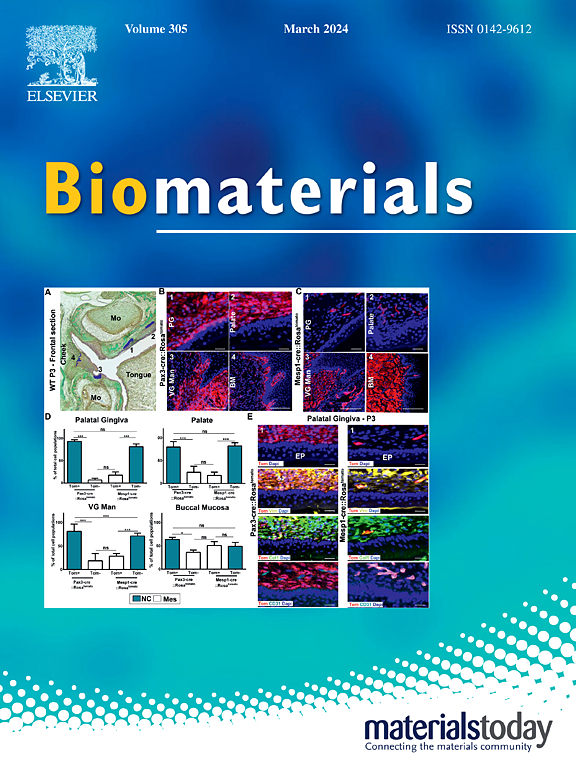Peritoneum-inspired adaptive hydrogel sheath orchestrating long-term lubrication and antibacterial properties for drainage tube intubation
IF 12.8
1区 医学
Q1 ENGINEERING, BIOMEDICAL
引用次数: 0
Abstract
Drainage tube (DT) intubation is frequently accompanied by distressing and even life-threatening complications. Herein, we engineer a peritoneum-inspired adaptive hydrogel sheath orchestrating long-term lubrication and broad-spectrum antibacterial properties onto the commercially-available DT surface for safe medical intervention. A thin conformal hydrogel sheath is formed by constructing the semi-interpenetrating hydrogel network to serve as the hydration layer, mimicking the lubricative peritoneal fluid layer of the peritoneum. The exposed protonated amino group of the semi-interpenetrating hydrogel network imparts the hydrogel sheath with an intrinsic antibacterial capacity, imitating the peritoneal inherent immunoregulatory function that resists bacterial invasion. The resultant hydrogel sheath exhibits the long-term lubricity, prominent broad-spectrum antibacterial property, remarkable robustness in various harsh environments, and excellent antifouling property without comprising biocompatibility. As demonstrated by an in vivo rabbit model of peritoneal drainage, the application of the hydrogel sheath on DT not only alleviates skin tissue trauma and inflammation effectively, but also inhibits bacterial invasion to avoid potential infection. The current work opens a valuable avenue to develop the functional DT to meet clinical needs.
腹膜启发自适应水凝胶鞘协调长期润滑和抗菌性能引流管插管
引流管(DT)插管经常伴有痛苦甚至危及生命的并发症。在此,我们设计了一种受腹膜启发的自适应水凝胶鞘,在商用DT表面上协调长期润滑和广谱抗菌特性,用于安全的医疗干预。通过构建半互穿水凝胶网络形成薄的保形水凝胶鞘作为水化层,模拟腹膜的润滑腹膜液层。半互穿水凝胶网络暴露的质子化氨基使水凝胶鞘具有固有的抗菌能力,模仿腹膜固有的抵抗细菌入侵的免疫调节功能。所得到的水凝胶鞘具有长期润滑性,突出的广谱抗菌性能,在各种恶劣环境下的显着稳健性,以及出色的防污性能,而不包括生物相容性。兔腹膜引流体内模型表明,水凝胶鞘在DT上的应用不仅能有效缓解皮肤组织的创伤和炎症,还能抑制细菌的侵袭,避免潜在的感染。目前的工作为开发功能性DT以满足临床需求开辟了一条宝贵的途径。
本文章由计算机程序翻译,如有差异,请以英文原文为准。
求助全文
约1分钟内获得全文
求助全文
来源期刊

Biomaterials
工程技术-材料科学:生物材料
CiteScore
26.00
自引率
2.90%
发文量
565
审稿时长
46 days
期刊介绍:
Biomaterials is an international journal covering the science and clinical application of biomaterials. A biomaterial is now defined as a substance that has been engineered to take a form which, alone or as part of a complex system, is used to direct, by control of interactions with components of living systems, the course of any therapeutic or diagnostic procedure. It is the aim of the journal to provide a peer-reviewed forum for the publication of original papers and authoritative review and opinion papers dealing with the most important issues facing the use of biomaterials in clinical practice. The scope of the journal covers the wide range of physical, biological and chemical sciences that underpin the design of biomaterials and the clinical disciplines in which they are used. These sciences include polymer synthesis and characterization, drug and gene vector design, the biology of the host response, immunology and toxicology and self assembly at the nanoscale. Clinical applications include the therapies of medical technology and regenerative medicine in all clinical disciplines, and diagnostic systems that reply on innovative contrast and sensing agents. The journal is relevant to areas such as cancer diagnosis and therapy, implantable devices, drug delivery systems, gene vectors, bionanotechnology and tissue engineering.
 求助内容:
求助内容: 应助结果提醒方式:
应助结果提醒方式:


